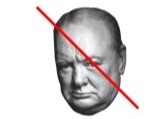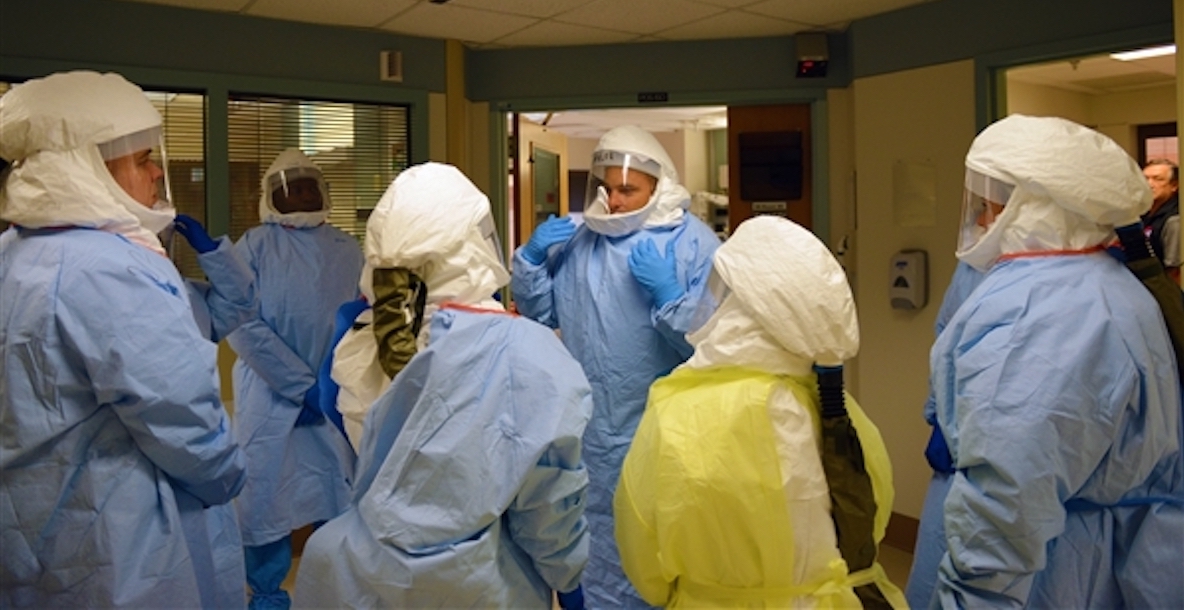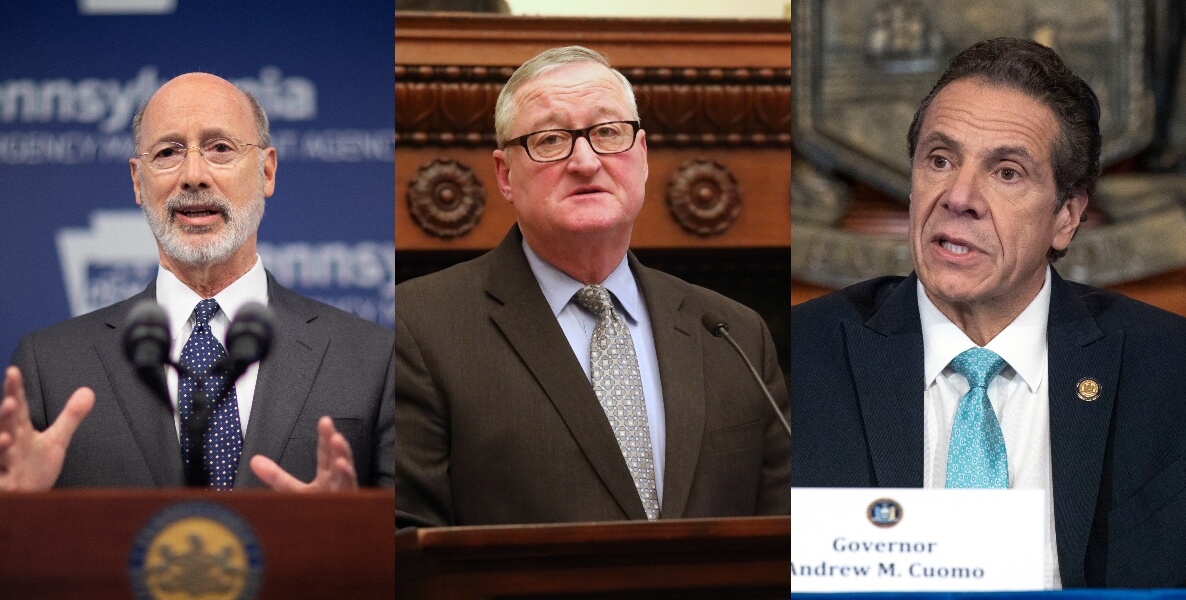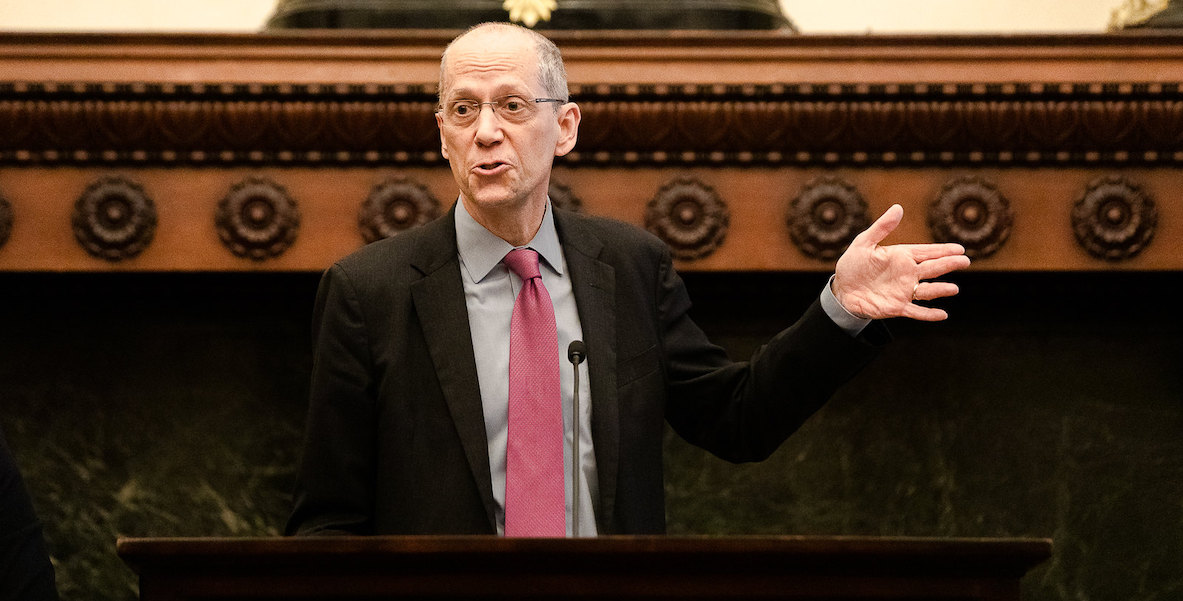![]() Good for the brilliant writer Erik Larsen, whose new book, The Splendid and the Vile, couldn’t come at a more propitious time. It’s an intimate portrait of Winston Churchill during World War II’s London Blitz, and it gives us a template for what real leadership looks like in an international crisis.
Good for the brilliant writer Erik Larsen, whose new book, The Splendid and the Vile, couldn’t come at a more propitious time. It’s an intimate portrait of Winston Churchill during World War II’s London Blitz, and it gives us a template for what real leadership looks like in an international crisis.
With his country—and the free world—on the precipice of being overrun by Nazi Germany, the new prime minister of Great Britain did what JFK would later observe of him: He “mobilized the English language and sent it into battle.”
Churchill, the man, had many flaws. But there he was as his country faced its darkest hour, meeting its most existential moment with startling candor and inspiration.
“Even though large tracts of Europe and many old and famous states have fallen![]() or may fall into the grip of the Gestapo and all the odious apparatus of Nazi rule, we shall not flag or fail,” Churchill said, in perhaps his most famous address. “We shall go on to the end. We shall fight in France, we shall fight on the seas and oceans, we shall fight with growing confidence and growing strength in the air, we shall defend our island, whatever the cost may be. We shall fight on the beaches, we shall fight on the landing grounds, we shall fight in the fields and in the streets, we shall fight in the hills; we shall never surrender.”
or may fall into the grip of the Gestapo and all the odious apparatus of Nazi rule, we shall not flag or fail,” Churchill said, in perhaps his most famous address. “We shall go on to the end. We shall fight in France, we shall fight on the seas and oceans, we shall fight with growing confidence and growing strength in the air, we shall defend our island, whatever the cost may be. We shall fight on the beaches, we shall fight on the landing grounds, we shall fight in the fields and in the streets, we shall fight in the hills; we shall never surrender.”
Larsen cites this as just one example of Churchill’s “knack for making people feel loftier, stronger, and, above all, more courageous,” noting Churchill’s oratorical pattern throughout the war of “offering a sober appraisal of facts, tempered with reason for optimism.”
Not only doesn’t Mayor Kenney see his daily press conference as an opportunity to lead Philadelphians toward changed social behavior, the dude would actually rather be somewhere—anywhere?—else.
It’s downright freaky to be lost in Larsen’s master class on political leadership today, when our airwaves are overrun with the press conferences of elected officials, all jockeying to lead. Let’s review them all on the basis of Churchill’s model.
He knew that, in times of uncertainty, citizens want to be shown the way. Not pacified, but…led, by someone with backbone, someone strong enough to feel their pain, someone eloquent enough to speak to it. Someone tough, but vulnerable; resolute, but practical. For our purposes, let’s break the tenets of Churchillian leadership into four components:
Facts. Churchill treated a frightened populace with respect by transparently giving it to them straight.
Accountability. Before Harry Truman ever put that sign on his desk, the world knew where the buck stopped in Great Britain.
Vision. Churchill’s mastery of dire facts were always followed by the vivid painting of a picture of better times ahead.
Inspiration. Hell, today, some 80 years later, ol’ Winston has me, a card-carrying coward, ready to go kick some Nazi ass.
So let’s skip over the clown show we’re seeing every day from the White House briefing room. Suffice to say that, on our scale of 1 to 5 Churchills, with 5 being positively Churchillian, Trump’s bumbling, frightened, fact-challenged and indecisive performances (he was a “wartime president” for all of a week) net him precisely 0 Churchills.
Donald Trump:

Next up, of course, is New York Governor Andrew Cuomo, whose daily press conferences have become appointment TV on CNN and MSNBC and have started a movement to draft Cuomo for president. According to the New York Post, women have been “coronavirus crushing” on Cuomo. “I love how he’s trying to calm us all down,” said one admirer.
Why all the Cuomo love? Because he has perfectly channeled the Churchillian way. Without notes, he reels off streams of data daily, arranging them into a gripping story about, as he put it this week, the approaching “bullet train”—an upgrade over “freight train.”
In times of uncertainty, citizens want to be shown the way. Not pacified, but…led, by someone with backbone, someone strong enough to feel their pain, someone eloquent enough to speak to it.
Like Churchill, Cuomo doesn’t just dryly recite facts. He connects those facts to a bold plan of action, conveying hope to a nervous and isolated electorate. Cuomo has never been known for his likability, (one story about him last week was headlined “Andrew Cuomo Is The Control Freak We Need Right Now” ), and nor has he been seen as an inspiring wordsmith, like his father.
No, Andrew Cuomo has been a deal maker who makes government work for progressive ends—often much to the chagrin of progressives, who scoff at his pragmatic ways. Of late, however, time and again he’s combined emotional connection with moral clarity to form stirring calls to arms, in a way we haven’t seen since…well, maybe Churchill.
Check out Cuomo’s response to the suggestion by the president and his economic advisor, Larry Kudlow, who said, “We’re going to have to make some hard choices,” intimating that there ought to be some sort of cost-benefit analysis applied to the saving of lives. That notion, hinted at by Kudlow and Trump’s “cure worse than the disease” ramblings was actually stated explicitly by the Texas Lieutenant Governor, who posited that “lots of grandparents” would gladly perish as a “gift” so everybody else could “get back to living.”
Enter Cuomo:
ANDREW CUOMO: 
But Cuomo’s not alone.
As the administration in D.C. has shown itself to be in over its head, other governors and mayors have stepped up. Another five Churchills, for example, go to Chicago Mayor Lori Lightfoot, who gave a rousing address on local TV to her city—“As Chicagoans, we may get bent, but we are never broken”—and who this week threatened to shut down parks and the lakefront if young people didn’t abide her calls for social distancing.
LORI LIGHTFOOT:

Another 5 Churchills goes to Los Angeles Mayor Eric Garcetti. He doesn’t approach Winston’s poetry or Lightfoot’s fire, but his response to Trumpian denial has been as good as it gets and he’s just as tough, threatening to shut off water and power to any non-essential business that is not complying with his “Safer at Home” restrictions.
ERIC GARCETTI:

Of course, Republicans can be Churchillian, too.
Ohio Governor Mike DeWine has made some tough calls—like postponing the state’s primary election—and, while he’s not a stirring orator, he’s been able to marshall public opinion through his folksy, grandfatherly persona, which comes naturally: The dude has 24 grandchildren. DeWine has hyped a social media dance challenge by a TikTok star —#distancedance—designed to get young people to sign on to social distancing. (Within hours, 3 million videos were posted).
MIKE DEWINE (docked one for lack of charisma):


Okay, so how are our guys doing?
At the state level, Governor Tom Wolf has made all the right moves, closing schools and all but “life-sustaining” businesses. Unlike, say, Lightfoot and Garcetti, he’s been mostly all hammer and no stick, quick to point out that his decrees rely on self-enforcement; “I’m not sending the State Police or National Guard out to do this,” he’s pointed out. Wolf can appear wishy-washy, as when he first exempted Philadelphia from his shutdown order, earning the rightful enmity of some of the city’s surrounding counties, who knew that you can’t isolate what you’re allowing to freely travel.
Still, on the whole, Wolf’s acts have been bold, though they’ve been done in a strikingly gentle way. In his press conferences, he speaks in a halting monotone that can come off as either soothing or disengaged, depending upon your perspective. He hasn’t exhibited Cuomo’s mastery of fact or talent for emotional connection (as when the New York governor bemoaned, due to social isolation, not “being able to kiss all over my daughter’s face, which she hates”).
Wolf is more Jimmy Carter than Churchill, but who among us wouldn’t settle for some Jimmy Carter right about now? Here he is, in a Carter-like sweater, a simple man, talking to us from the heart:
So let’s penalize Wolf a bit for his inspiration deficit.
TOM WOLF:

Which brings us to our mayor.
Jim Kenney’s first foray into crisis management got off to an inauspicious start. Early on, he was Trump-like in his denial of the scope of this crisis, at one point urging residents to “go out and have dinner and tip your waitstaff.” Facing backlash, he later took to Twitter and urged residents to order takeout instead.
In normal times, Kenney’s concern for the economic well-being of waiters and waitresses would be laudable, but this was proof he wasn’t seeing clearly what he was up against: You do working folks no service by disproportionately risking their rate of infection.
In fact, let’s stipulate that Jim Kenney’s heart always seems to be in the right place. I’ve seen him interact with Philadelphia schoolchildren, and his level of care is always a touching sight to behold. But every leader in times of crisis has good intentions.
The difference-maker is who steps up with vision and inspiration and a plan. On that score, Kenney’s daily press conferences have been downright weird. You can watch them everyday at 1pm at phila.gov/PHLgovTV, as I have for the last 10 days or so.
![]() What’s so weird about them? Well, the mayor rarely speaks. City Health Commissioner Tom Farley and Managing Director Brian Abernathy do most of the talking, and when the mayor does talk, it’s usually in clipped sentences—brief, dour-faced soundbites, in stark contrast to, say, the way Cuomo walks you through the state of things, gets your buy-in, makes you feel like a partner in a common cause.
What’s so weird about them? Well, the mayor rarely speaks. City Health Commissioner Tom Farley and Managing Director Brian Abernathy do most of the talking, and when the mayor does talk, it’s usually in clipped sentences—brief, dour-faced soundbites, in stark contrast to, say, the way Cuomo walks you through the state of things, gets your buy-in, makes you feel like a partner in a common cause.
Often, Mayor Kenney will read from an opening statement—one day it’s a response to Trump; another it’s highlighting the PHL Covid-19 Fund, in partnership with the Philadelphia Foundation and United Way; still another focuses on the “power of prayer”—and then he’ll sit in a chair some distance from the microphone while Abernathy and Farley field questions.
Because I have no life, I’ve spent the last two weeks watching nothing but coronavirus press conferences from around the nation, and Philly leads the league in simply not answering questions.
Reporters—now attending virtually via Zoom—have to ask for the mayor, and he’ll trudge up to the microphone to respond to a question. Once last week, Inquirer reporter Sean Collins Walsh, asking questions on behalf of many in the newsroom, had to ask for the mayor and fired a series of questions at him, none that remarkable. One on the letter to Congress from 300 mayors Kenney signed, seeking direct stimulus bill funds; one on the economic effects being felt by the local construction industry; one on the state of the city pension system.
But here was the remarkable thing: After each response, Kenney tried to slink his way back to his chair, only to have to walk back to the microphone, time and again. The message was clear: Not only doesn’t the mayor see his daily press conference as an opportunity to lead Philadelphians toward changed social behavior, the dude would actually rather be somewhere—anywhere?—else.
At one point, Walsh requested the mayor yet again, and asked almost plaintively: “How are you doing with all this?”
It was an invitation for a leader to establish an intimate connection with his constituency, as Cuomo has done. When the New York governor, talking about protecting his 88-year-old mother, says that she’s “all light and joy,” he’s really talking about your mom, and my mom. Far from self-indulgence, he’s opening a vein so we all don’t feel quite so alone. How did Mayor Jimmy respond?
“Oh, I’m just fine, it’s been great,” he said, in a sarcastic tone. “I live alone. I’m continuing to Purell my hands and trying to distance people…Would I rather this have not happened? Yes, but we’re moving forward.”
Not exactly Churchillian, is it? I was leaning towards giving Kenney three Churchills—middling, but grading on a curve, because I have no doubt the guy really cares—but what tipped the scale to two is the performance by both Farley and Abernathy.
JIM KENNEY:

Don’t get me wrong; both are smart, well-intentioned public servants, but, because I have no life, I’ve spent the last two weeks watching nothing but coronavirus press conferences from around the nation, and Philly leads the league in simply not answering questions. The number of times either Farley or Abernathy respond by saying “I don’t have that information for you” is disproportionate compared to other cities.
I’m talking about basic information, the kind Cuomo provides every day. How ![]() many face masks and ventilators we have. The number of patients currently in ICU. When modeling predicts the peak of the wave will hit. (Dr. Larry Jameson, Penn Medicine’s Dean, cited the school’s modeling on MSNBC Wednesday night, which targets May 10 as the date our emergency room departments will face New York-like crisis levels; why are we not hearing that from the mayor?) In New York, over 200 police officers are out sick with coronavirus symptoms. Philly, Abernathy said earlier this week, won’t be releasing similar details here.
many face masks and ventilators we have. The number of patients currently in ICU. When modeling predicts the peak of the wave will hit. (Dr. Larry Jameson, Penn Medicine’s Dean, cited the school’s modeling on MSNBC Wednesday night, which targets May 10 as the date our emergency room departments will face New York-like crisis levels; why are we not hearing that from the mayor?) In New York, over 200 police officers are out sick with coronavirus symptoms. Philly, Abernathy said earlier this week, won’t be releasing similar details here.
No doubt, Farley and Abernathy’s lack of responsiveness compared to other cities is about leadership, too. They’re following the mayor’s tight-lipped lead. And that’s too bad, because, as Cuomo, Lightfoot and others are showing, and as Churchill modeled for every one of them, there’s an opportunity in times of crisis for leaders to step up to soothe, challenge and inspire us.
Churchill photo-illustrations by Lucy Ferry.










